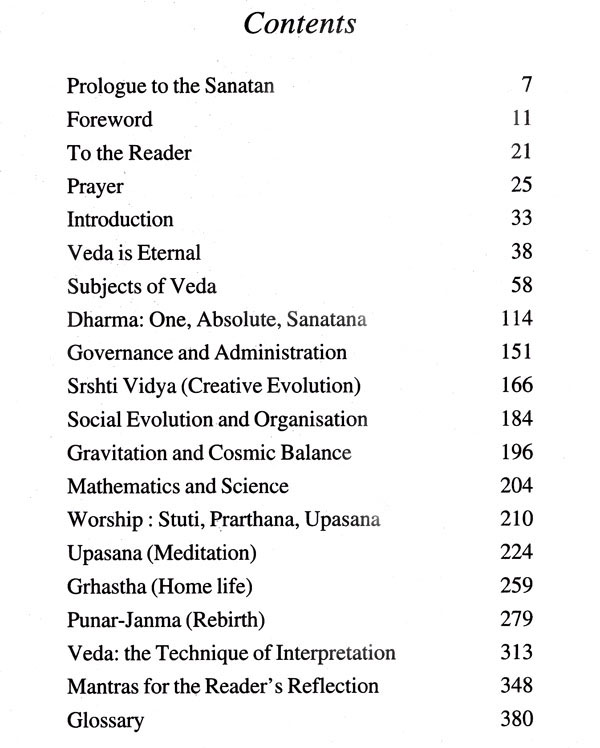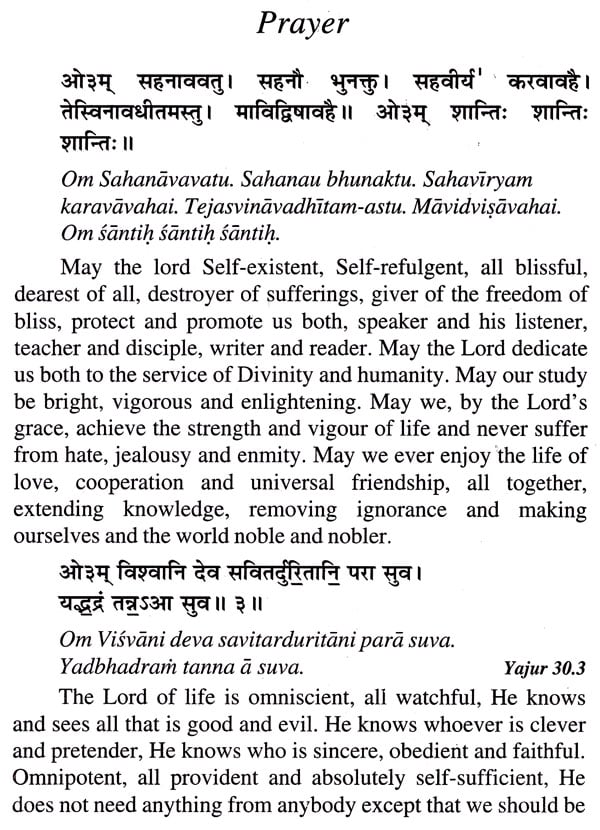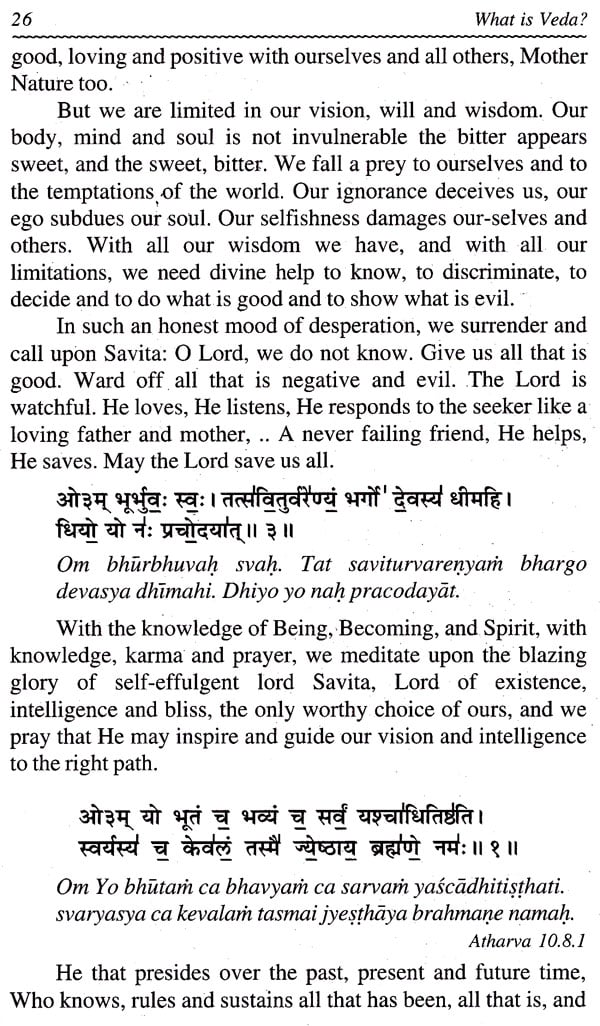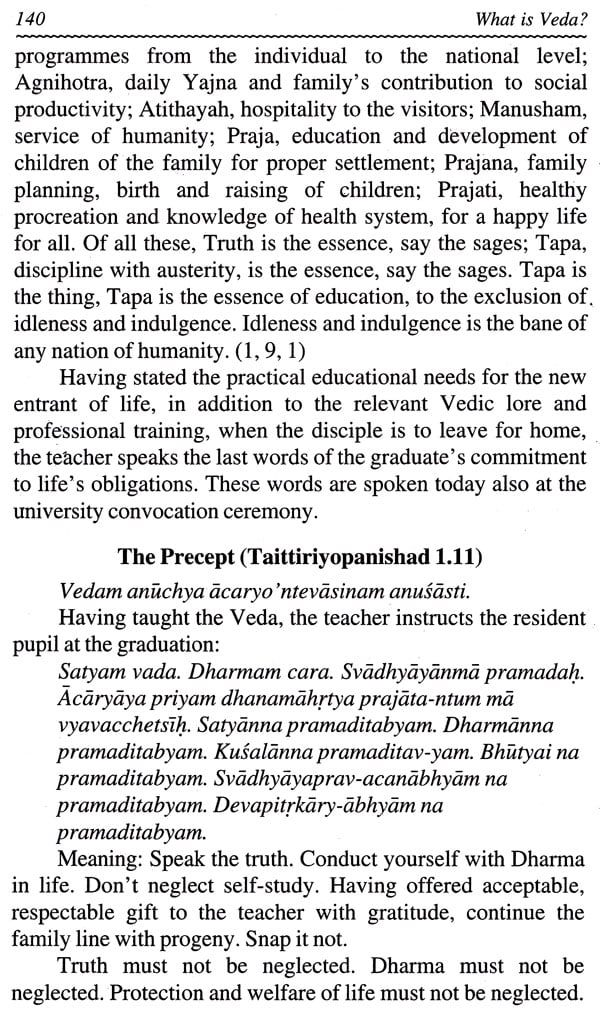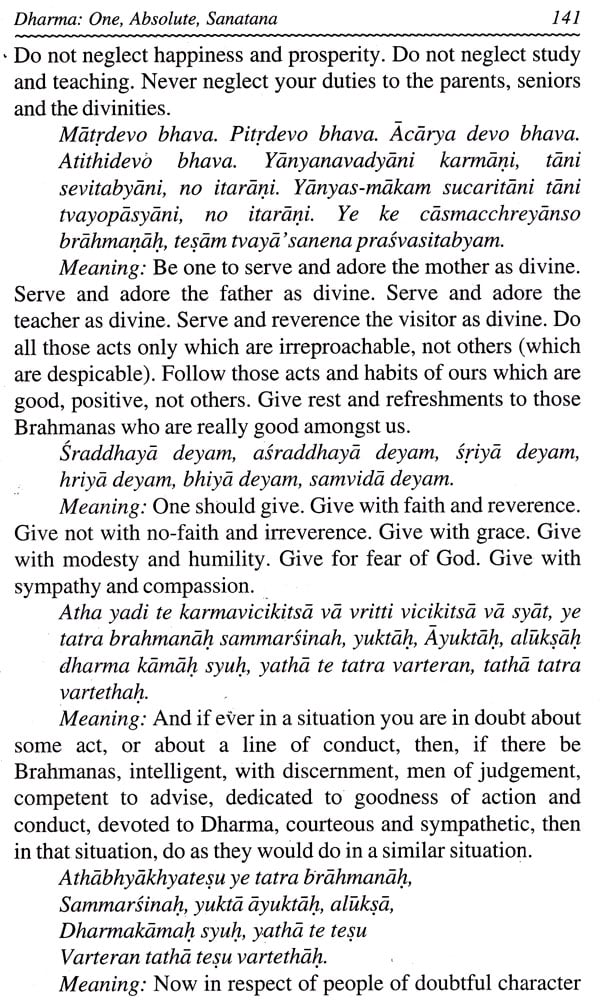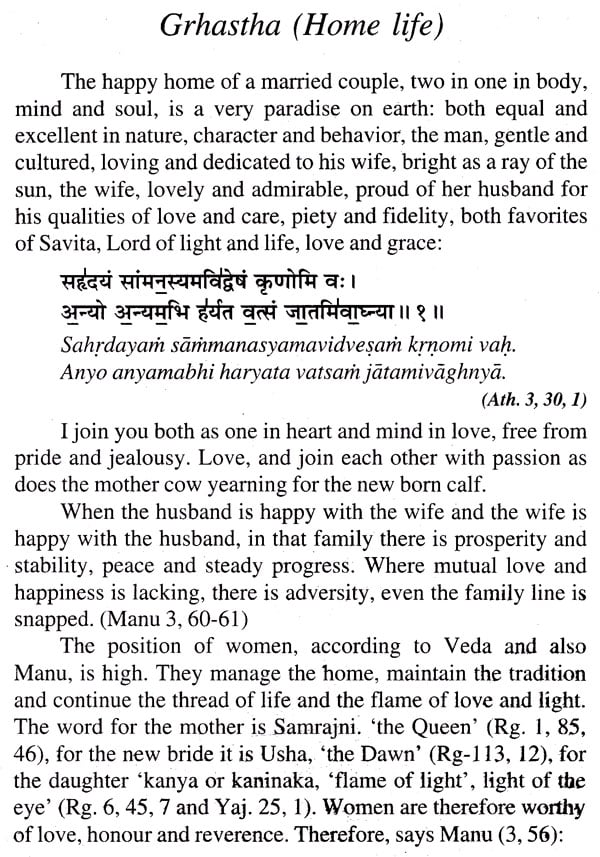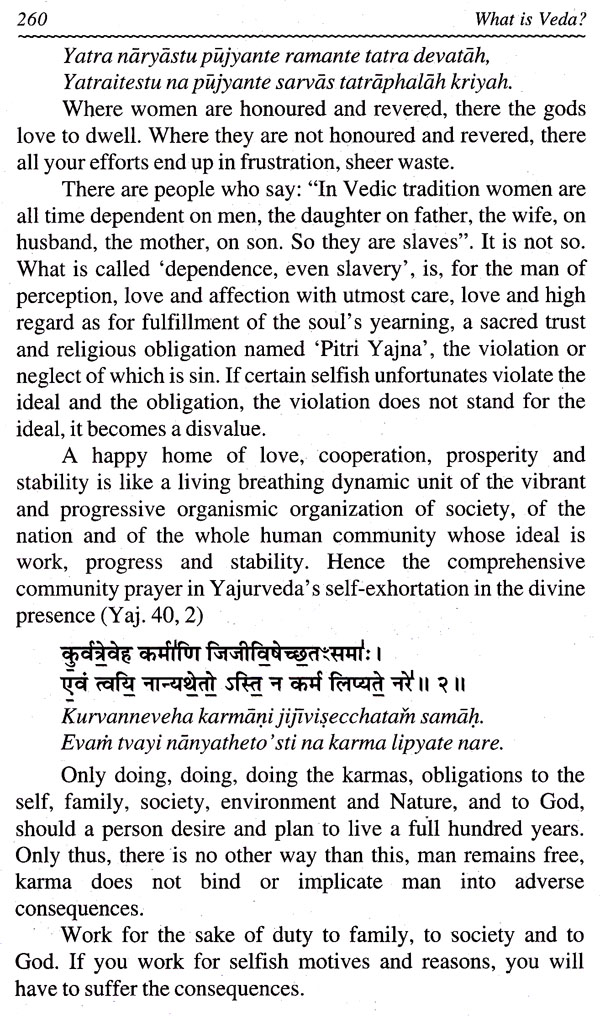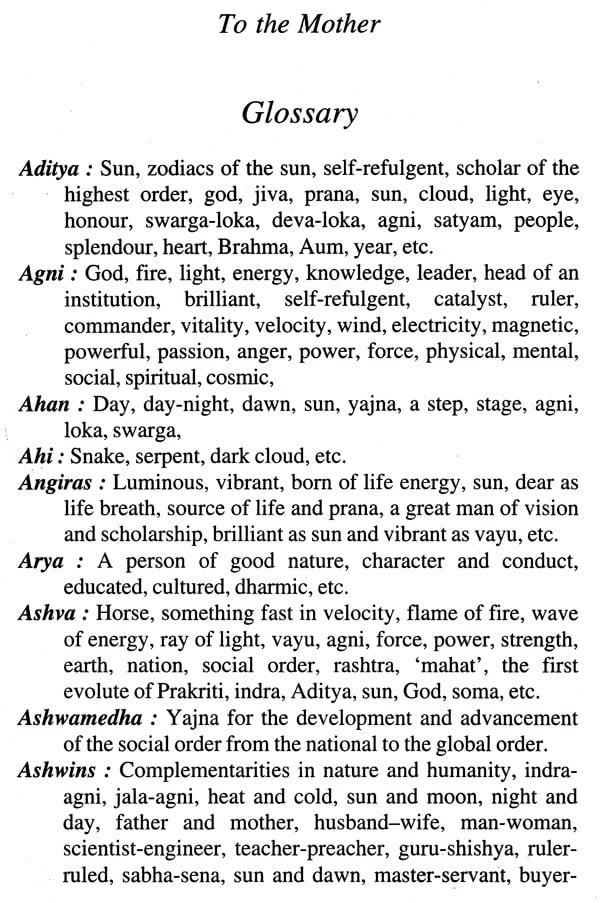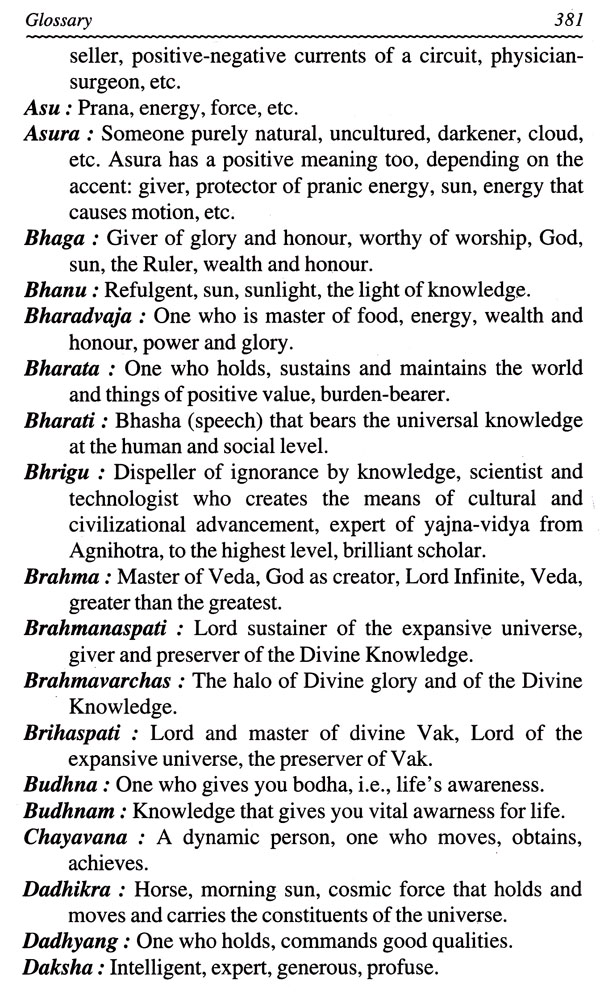
What is Veda (Sanatana Foundation of Universal Dharma)
Book Specification
| Item Code: | NAS695 |
| Author: | Dr. Tulsi Ram Sharma and Gianender Kumar Sharma |
| Publisher: | Govindram Hasanand |
| Language: | Sanskrit Text Transliteration with English Translation |
| Edition: | 2015 |
| ISBN: | 9788170772316 |
| Pages: | 390 |
| Cover: | PAPERBACK |
| Other Details | 8.50 X 5.50 inch |
| Weight | 420 gm |
Book Description
Veda is the Sanatan foundation of Universal Dharma, original, ancient, Sanatan yet modern, living in creative response to the changing circumstances.
Sanatan Dharma till today has passed through many historical stages: the Original Vedic in what is called the Vedic age, then ritualistic, pure as well as distorted, theistic, even non- theistic, ethical, moral, symbolic, mythological, with even a variety of 'Gods' divine and human, until the time of Swami Dayananda and after.
Beyond this historical variety of Dharma, as Swami Dayananda asserted, this book concentrates on the Original Vedic Dharmik message of Jnana (Knowledge), Karma (active Living), and Upasana (Praise, Prayer and Meditation). It covers the knowledge and modern relevance of creative evolution of the world, material, biological, spiritual and socio-political.
It covers the Vedic knowledge of Shruti, Smriti, Sadachara and freedom of Conscience, and many other themes such as age of the Vedas, Devata, science, society, karma and the karmic cycle, punarjanma with reference to reincarnation in other traditions.
Written on the model of Swami Dayananda's Rgvedadi Bhci`shy a Bhumikci, this book takes into account the change of circumstances while dealing with Vedic themes in relation to present time. In this I.T. age of science, democracy and globalism, you will feel surprised by the modernity of the ancient and the timeless.
Dr. Tulsi Ram Sharma M.A. English (Delhi, 1949), P h.D. (London, 1963) has been a university professor, academic administrator, researcher, and writer of long standing with prestigious assignments.
Besides his professional studies of secular literature in English, Hindi, Sanskrit and Urdu, Dr. Tulsi Ram Sharma has devoted his life and time to the study and discipline of Sacred literature specially Vedas, Upanishads, Darshan Philosophy, Puranas, Ramayana, Mahabharata with concentration on the Bhagwad Gita, Greek, Roman, Sumerian and English Epics, Gathas of Zarathustra, ulsi Ram Sharma Bible, Quran, and the writings of Swami Dayananda, and Swami Vivekananda, in search of the essential values of Sanatan Vedic Dharma with reference to their realisation in life and literature through social attitudes, collective action, customs, traditions, rituals and religious variations across the fluctuations of history.
Dr. Tulsi Ram Sharma has spent the last ten years on translation of the four Vedas, all the time saying: "I came for this". While English has been the language of his professional communication, Sanskrit is the voice of his life and living.
"The more we know the Veda, the more we know, and the more we know, the more we know the Veda": this sums up Dr. Tulsi Ram's life time search for the Vedas and the mystery of life we live during the current phase of our existence.
I have known Dr. Tulsi Ram as a University professor, researcher, scholar and writer for a long time. With a first class Masters in English from Delhi University and Ph. D. from London (U.K.), while he has pursued his professional studies in English language and literature, he has dedicated himself to sacred Sanskrit literature with special emphasis on the Vedas, Brahmanas, Darshan philosophy, Pureinets and the Epics, the Ramayana and the Mahabharata with comparative reference to Greek, Roman, Portuguese and Sumerian heroic poetry and the Avesta, the Bible and the Quran. His approach to literature, both sacred and secular, is objective, comprehensive, and positive. For him, as universally acknowledged, Veda is the most ancient, original and universal knowledge of existence for all mankind without exception and without any reference to any particular time, place or community. It is Shruti, Reception of the Cosmic articulation of the Cosmic Vision by the primal sages in the state of clairvoyance (Samadhi).
For me, it is a pleasure to join a friend, a dedicated scholar, and a committed seeker of the Vedas and write a `prelude' to his Introduction to the translation of the Vedas in English in the line of Yaska, Panini, Patanjali and Dayananda, which I am sure, will be accepted and appreciated by the general readers and the scholars as an authentic restatement of the Vedic Voice in an international modern language. I congratulate Dr. Tulsi Ram and wish him all well for good health and long age for the continuance of his holy pursuit of the sacred mission.
Veda: Sanatana Foundation of Dharma reads like the morning breeze at dawn inspiring you to wait for light of the day-Vedas and the Vedic tradition, followed from the birth of civilization through all the variations and fluctuations of history and Sanatana Dharma in Bharat and elsewhere in the world in the form of Smrities and the Scriptures.
Veda is the most ancient, first, Original Shruti known to mankind. It is universal Knowledge, an articulation of Cosmic Awareness, self-existent, vibrating in the heart beats of Nature and vested in the deepest core of the human spirit (Yajurveda, 34-5).
If by a strange accident, all the Scriptures of the world were lost in this Computer age, would mankind be able to reclaim the lost knowledge? Yes, man himself, the Rshis, Dhyanayoganugata, in deep meditation at the frequency of the Cosmic Mind, would be able to envision and reclaim the Devatmashakti, presence of God, the atman, the Prakrti, and the universal awareness of existence in the Vedic Voice. They would perceive, articulate and pronounce the words of universal knowledge in the universal language of the men in direct communion with life. According to the Veda, the uni-verse is not a dead material machine, it is a living, breathing, in-telligent, self-organizing, self-existent, self-articulating Sovereign Purusha, constantly in communication with man. Only if we knew this!
It is difficult for the modern man of science and reason to accept anything beyond sense and reason. Only by direct sense experience and rational analysis, the scientists try to know the ultimate truth of existence. And the ultimate for them is Nature, not the Spirit of It, so far. But the scientists of the highest order are, certainly, faced with the mysteries of life and existence, they do accept the mystery and efficacy of mind too. One of the historians of the Royal Society of Science, in 1662, in one of his poems did accept that reason does lead you but leaves you at the door of faith in the presence of God.
During the year 2005, the Centenary Year of Einstein's Theory of Relativity, some of the Nobel Laureates of Physics did accept and say that Einstein's discovery of Relativity was the result of his "thought experiment". In Yoga philosophy "thought experiment" is Vichara Samadhi in which the yogi's reach is from the Paramanu (the initial particle) to the Mahatweinta (greatest of the great Ultimate). Einstein discov-ered that matter and energy are inter-convertible and that they are indestructible. Had he read the Vedas, at least Sankhya and Vedanta, he would have discovered the ultimate unity of the infinite variety of this expanding universe, the eternality and inter-convertibility of thought, energy, and matter, Sattva, Rajas, and Tamas.
Had even I.A.Richards, an eminent literary critic and scholar, who is known as the author of the 'Semantic Triangle' in Linguistics, known the Yogasutras, he would have acknowledged his debt to Patanjali, author of Yogasutras, who really was the first author of the Triangle of Shabda, Artha, Pratyaya, the word, the thing the word signifies, and the meaning, the association of the word, the thing, and the meaning existing in the mind. The Rgveda (1, 13, 9) states this triangle in Ila, Saraswati, Mahi ultimate terms.
In the Vedic tradition, we have Parama-Brahma, Shabda-Brahma, and Jagad-Brahma, all united. The Rgveda states this Unity in 10-129-2. It states the implosion of this unity into two, the constant and the mutable (10-190-1). The Sankhya traces the evolution of the Duality into the Multiplicity of the One, the two, and the three upto the infinite many. The Veda is the articulation of the Seed-state-One (Hiranyagarbha), and the evolution of this three-in-One into the expansive universe, and then the devolution of the variety back into the United One, Brahma with Its Shakti. The same process is pointedly stated in the Gita (7, 4-5), Atharva (9-9-20) and Shveta-shvataropanishad (4-6). Dr. Tulsi Ram, author of this Introduction to Veda and Sanatana Dharma, presents these mysteries in this book in a foreign language, the spirit of Sanskrit restated in English closest to the spirit.
Another problem: Veda is old, the world is new, chang-ing: Old order changeth yielding place to new. Values change, and we too must change and accept the newer values. "Move on, don't look back", grand mother used to say in the fairy tale, "You will turn to stone". This is the attitude of the modern westernised 'converts' too, especially those who are cut off from the Indian roots. As the great art critic Ananda Coomaraswamy once wrote: "A single generation of English education suffices to break the threads of tradition and to create a non-descript and superficial person deprived of all roots--- a sort of intellectual (non-specimen) who does not belong to the West or East." We must get back to the roots, to understand our Vedic tradition and then up and onwards from there move to the modern. How?
Listen to Atharva (10, 8, 23): The theme of this Sukta is Brahma. It says: "It is Sanatana, Eternal, Universal, Perma-nent, and yet every moment It changes and renews Itself into the modern, just as every day is new, and every night is new, in relation to each other." Values, according to Veda, are permanent, only the medium and methods of their realization change. For example, our Sanatana values are Satyam, Shivam, Sundaram (the True, the Good, and the Beautiful). If you concentrate on the Beautiful, you will see that the fashions of the realization of the Beautiful have been changing. But you will also realize that in relation to the changing forms, the Beautiful has remained the permanent value all through, only the fashions have been changing. Just the same way, you as Atma are the same entity though your states of body, age and office have been changing. Newness or Modernity is an attitude of the mind, a state of being which is dynamic, not static. Every day you change in body, but you remain the same person. Values remain the same, the media change.
Another question: Ours is an age of democracy and secularism.
**Contents and Sample Pages**
